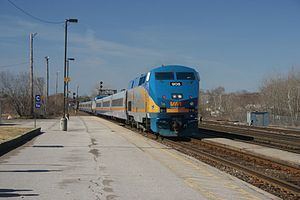Type Inter-city rail Opened 1856 Number of tracks 2+ | System Via Rail Operator(s) Via Rail | |
 | ||
Locale Quebec City–Windsor Corridor Owners Canadian National Railway, Via Rail, Metrolinx, Canadian Pacific Railway Terminis Gare du Palais, Windsor railway station | ||
The Corridor is a Via Rail passenger train service area in the Canadian provinces of Quebec and Ontario.
Contents
- High speed proposal
- Improvements to Corridor
- Primary inter city Corridor routes
- Commuter rail
- References
Corridor is used by Via to refer to all Via inter-city passenger trains which start and end within the geographic region known as the Quebec City–Windsor Corridor. Other inter-city trains from outside the Corridor may have their terminus at stations in the Corridor, such as the Canadian and the Ocean, but are marketed by their respective train names and are not considered to be Corridor services.
The Corridor service area has the heaviest passenger train frequency in Canada, with 36 Via trains traversing the route daily. About 67% of Via's revenue comes from Corridor routes.
Via runs a mix of local-service and express trains in the Corridor. Most of the trackage is owned by CN, although Via also owns three former freight lines, one from Smiths Falls, Ontario to Coteau-du-Lac, Quebec via Ottawa; one from Chatham, Ontario to Tecumseh, Ontario; and one from Smiths Falls to Brockville, Ontario.
Prior to Via's formation in 1978, CN Rail operated trains on the same tracks and CP Rail also offered limited service.
All trains are identified by number; however, in previous schedules these trains were named as well.
High speed proposal
During the 1970s and early 1980s, CN and later Via Rail operated the Turbo Train on existing freight rail trackage. This equipment was later replaced by the Bombardier LRC (Light, Rapid, Comfortable) train sets. Beginning in the 1980s and through the 1990s, Via Rail, Bombardier and the provincial and federal governments studied the feasibility of establishing a dedicated high-speed passenger rail network linking Quebec City–Montreal–Ottawa–Toronto–Windsor similar to the French TGV as a means of reducing domestic air and highway travel between these destinations.
After a hiatus of ten years, a feasibility study on launching a high-speed rail service in the Corridor will be updated at the joint cost of the federal government, Ontario and Quebec. On November 14, 2011, the three governments officially released the final report of a high-speed rail study for this corridor.
On December 5, 2014, the MTO approved the start of an Environmental Assessment on the best route for a high speed rail connecting Toronto, Kitchener-Waterloo, London, and Windsor for 2015.
Improvements to Corridor
In 2009–2010, Via used C$300 million of government stimulus money to upgrade segments of the Corridor. Notable track improvements planned were an additional 70 km (43 mi) of third main track in four segments, and a short segment of fourth main track, as well as additional yard tracks at three locations. Improvements were made to several stations along the line, with new station buildings being constructed at Belleville and Cobourg, and additional platforms for existing stations at Brockville and Oshawa. The improvements were planned to reduce delays along the route and to allow for a reduction in travel time of up to 30 minutes from end to end. They were intended to allow Via to introduce two new round-trip trains from Toronto to both Montreal and Ottawa without requiring the acquisition of new equipment.
Primary inter-city Corridor routes
The Maple Leaf, a through service from Toronto to New York City, operated jointly with Amtrak, is crewed by Via as trains 97 and 98 on VIA schedules, between Toronto and Niagara Falls, and can be considered part of Corridor services as well. It is the only scheduled rail service from the Corridor line at Burlington to Niagara Falls.
Commuter rail
Two commuter rail agencies, provincially funded and independent of Via, share tracks with Via's Corridor trains.
